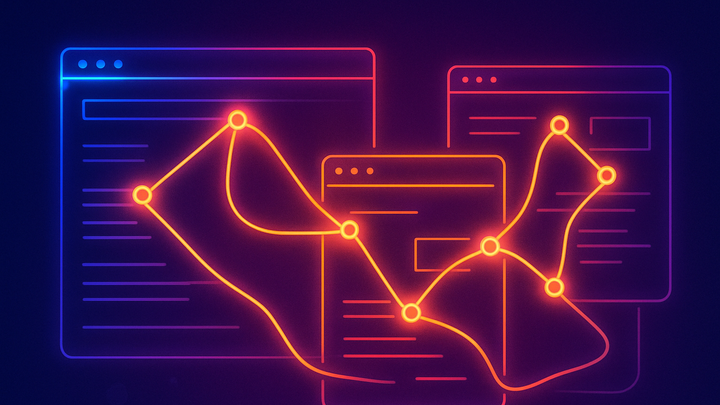Published on 2025-06-26T05:32:36Z
What is Clickstream Analysis in Analytics? Examples & Use Cases
Clickstream analysis is the process of capturing, processing, and examining the sequence of pages, clicks, and interactions that users make as they navigate through a website or application. By reconstructing these user journeys, analysts can identify common paths, detect friction points, and optimize navigation flows for better user experience and higher conversion rates. This technique provides a granular, time-ordered view of user behavior, enabling teams to:
- Improve site architecture by understanding how users move between pages
- Enhance marketing strategies through behavioral segmentation and personalization
- Troubleshoot performance issues by correlating click patterns with load times
Data for clickstream analysis can be collected via client-side methods (like JavaScript tags), server-side logs, or hybrid approaches that balance depth of insight with privacy concerns. Leading SaaS platforms such as PlainSignal (a cookie-free analytics tool) and Google Analytics 4 (GA4) provide robust clickstream tracking, reporting, and visualization capabilities. In an era of tightening privacy regulations, cookie-free and server-side tracking solutions are increasingly vital for maintaining compliance without sacrificing actionable insights.
Clickstream analysis
Process of capturing and analyzing user click paths to optimize navigation, user experience, and conversions.
Overview of Clickstream Analysis
Clickstream analysis entails recording the exact sequence of pages, events, and interactions a user follows during a session. It transforms raw click and pageview data into structured clickstream records, enabling analysts to reconstruct and visualize user journeys. This foundational insight helps digital teams understand user intent, optimize site structure, and improve content discoverability.
-
Definition
The systematic process of capturing, storing, and examining the sequence of user interactions on a website or application.
-
Importance
Provides in-depth visibility into user behavior, highlights navigation bottlenecks, and informs data-driven decisions to enhance engagement and conversions.
Data Collection Methods
Clickstream data can be collected using various techniques, each with trade-offs in terms of accuracy, privacy, and implementation complexity. Choosing the right method depends on your compliance requirements, data granularity needs, and infrastructure capabilities.
-
Client-side tracking
Uses JavaScript snippets that run in the user’s browser to capture clicks, pageviews, and custom events in real time.
-
Javascript tags
Lightweight scripts embedded in HTML capture user interactions and send them to analytics servers.
-
Cookie and local storage
Stores session identifiers and user preferences to stitch events into continuous sessions without server logs.
-
-
Server-side tracking
Leverages web server logs or backend APIs to record page requests and events, offering greater control over data collection and privacy.
-
Web server logs
Automatically record each HTTP request, including URL, timestamp, and response codes, without requiring client scripts.
-
Api-based tracking
Directly sends event data from server-side applications to analytics endpoints for more reliable delivery under strict privacy rules.
-
Key Analysis Techniques
Once clickstream data is collected, analysts use specific techniques to extract actionable insights, optimize user flows, and measure performance across different segments.
-
Path analysis
Maps and visualizes the most common navigation paths users take through a site or application.
-
Common path identification
Detects the most frequent sequences of page visits to optimize site layout and content placement.
-
Drop-off path detection
Highlights paths where users tend to exit, helping to identify friction points and improve retention.
-
-
Funnel analysis
Tracks user progress through a predefined set of steps (a funnel) to calculate conversion rates and pinpoint drop-off stages.
-
Step definition
Defines critical user actions (e.g., add to cart, checkout) that constitute the funnel stages.
-
Conversion rate calculation
Measures the percentage of users who move from one funnel stage to the next to identify optimization opportunities.
-
-
Sessionization
Groups individual user events into coherent sessions based on time thresholds or activity rules.
-
Timeout thresholds
Configures how long a session remains active after the last user interaction (commonly 30 minutes).
-
Session stitching
Merges events across devices or browser sessions for a unified view of the user journey.
-
Implementing Clickstream Analysis with SaaS Tools
Leading analytics platforms simplify clickstream tracking, data collection, and reporting. Below are examples of integrating PlainSignal and Google Analytics 4 on your website.
-
PlainSignal integration
PlainSignal is a cookie-free analytics tool focused on privacy and simplicity. To start collecting clickstream data, add the following HTML snippet to the <head> of your pages.
-
Tracking code snippet
<link rel="preconnect" href="//eu.plainsignal.com/" crossorigin /> <script defer data-do="yourwebsitedomain.com" data-id="0GQV1xmtzQQ" data-api="//eu.plainsignal.com" src="//cdn.plainsignal.com/plainsignal-min.js"></script>
-
-
Google analytics 4 integration
GA4 uses an event-based model to capture rich clickstream data and advanced metrics. Insert this tag into your HTML to begin tracking.
-
GA4 tracking code snippet
<script async src="https://www.googletagmanager.com/gtag/js?id=G-XXXXXXXXXX"></script> <script> window.dataLayer = window.dataLayer || []; function gtag(){dataLayer.push(arguments);} gtag('js', new Date()); gtag('config', 'G-XXXXXXXXXX'); </script>
-
